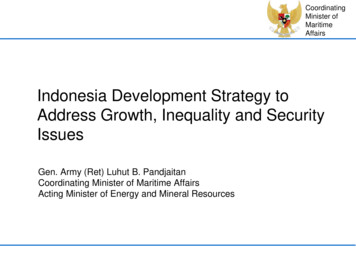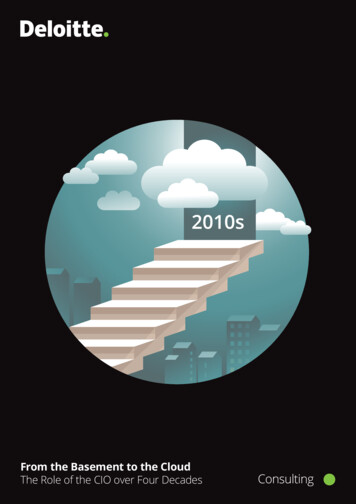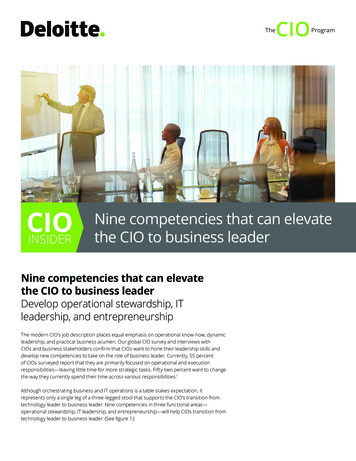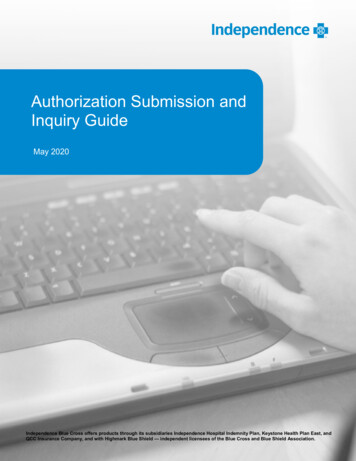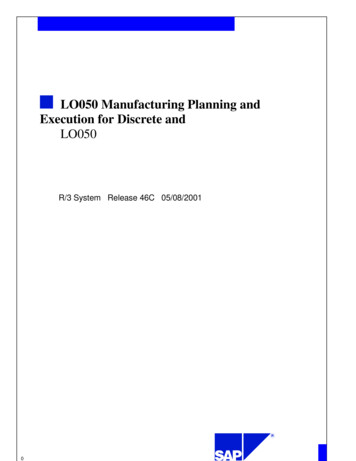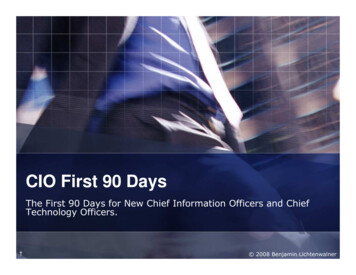
Transcription
CIO First 90 DaysThe First 90 Days for New Chief Information Officers and ChiefTechnology Officers.† 2008 Benjamin Lichtenwalner
Outline IntroductionBackground OverviewThree P’s People Products ProcessTimeLine First 30 Mid 30 Last 30Summary † 2008 Benjamin Lichtenwalner
IntroductionA quick background on who this guy Benjamin Lichtenwalner (Lickten-wäl-nur) is and why he is interested in the first days for CIOs EducationPenn State UniversityLehigh UniversityBS Management Science & Information SystemsMBA Concentrated in Corporate EntrepreneurshipExperienceFortune 500 (E-Business Division Start-up); Inc. 500 (ERP Supporting HighestGrowth Phase); NPO (Scaled Technology for 50% Growth 12 months).Positions HeldSupport Analyst, Software Developer Roles, Technical Lead (Software design /architecture), Project Manager Roles, Vice President of Technology (CIOresponsibilities).Why First 90? † Seen it done right, seen it done wrongDid it right myself, did it wrong myselfLots of great books (recommended), but often not readBeen through the pain, trying to spare others 2008 Benjamin Lichtenwalner
Introduction: Background Why the first 90 Days? Will it vary by organization? AbsolutelyJust one example hereRisks of unstructured plan? †Organization is waiting for your impactChange is often needed quicklyPrioritization is criticalSo much to do Poor prioritizationMiscommunicationLack of organizational confidenceWasted ResourcesIneffective lieutenantsUnhappy technology staffBottom line performanceYour job 2008 Benjamin Lichtenwalner
Introduction: OverviewFor simplicity and recollection, a framework of People, Productsand Processes are addressed over 3 stages of 90 days.Three P’s People: For each stage, the people you speak with and what you focus onin those conversation should vary.Products: For the purposes of this brief presentation, products refers toanything that may be considered a deliverable of your IT department:applications, infrastructure, policies, support and so on. Yes, it is a bigcategory.Processes: You wouldn’t be where you are today without realizing theimportance of process. However, there are different degrees of attentionthat you should pay to process in your first 90 days.90 Days †First 30: Emphasizes high level conversations and getting to know the neworganization or role.Middle 30: Digging into details.Last 30: Established what needs to be done, began the communication andbuilding relationships. 2008 Benjamin Lichtenwalner
“The Three Ps”People, Products & Processes† 2008 Benjamin Lichtenwalner
Three P’s: People Levels of OrganizationMost organizations large enough to support a CIO/CTO have at least 3categories of staff: Executives, Lieutenants and Individual Contributors Executives CEO CxOs Vice Presidents (SVPs) Lieutenants Directors Managers Line of Business (LOB) Leaders Individual Contributors Technology Staff Other People †At least top 2 acrossAs many as possible, according to sizeVendors / PartnersConsultants / ContractorsCompetitors / Similar OrganizationsRegulators 2008 Benjamin Lichtenwalner
Three P’s: ProductsAt the highest level, the key areas of Products to focus on includeInfrastructure, Applications and Services Infrastructure Applications DesktopCommunication (Email, Chat, CRM, Telephony )Back Office (Accounting, Finance, Inventory, HR )Data Stores (DBs, Intranet, Knowledge Management )LOB Solutions (Engineering, Sales, Content Delivery )Services †WorkstationsServersTelecommunicationsProject ManagementApplication DeliverySupport / MaintenanceOutsourcingPolicies 2008 Benjamin Lichtenwalner
Three P’s: ProcessesThere are many processes to understand in your first 90 days.Many may be just unstructured communications – but they are stillprocesses to understand. Key here is knowing who to contact,when and how, both within IT and across the organization. Budget Project Intake (IT)PrioritizationChange ManagementStrategic Planning (and CIO’s Role)SupportAccountability †Tracking / ForecastingPurchase Orders / ExpenseBudgetIT Organization (Scorecards)Performance Management 2008 Benjamin Lichtenwalner
TimelineFirst 30, Middle 30 and Last 30 Days† 2008 Benjamin Lichtenwalner
Timeline: First 30 DaysThe first 30 days emphasizes high level conversations and gettingto know the new organization and / or role. Therefore, the newCIO should focus on meeting with executives and technology staff,while understanding the most critical products and immediatelynecessary processes.Major Themes: Research individuals Carefully prepare questions Be a sponge: listen, listen, listen and absorb Document and structure feedbackBy the end of the first 30 days, you should start to have a feel forthe organization. There should also be a sense of where the majorpain points are and an idea of where you will begin to focus yourenergies in the first year.† 2008 Benjamin Lichtenwalner
Timeline: First 30 Days - People Executives Technology Staff †Most senior executives (CxO, SVPs)What has worked well and what has not?What are the most urgent IT needs?What are the cyclical needs?Gather existing performance reviews & resumesAt least top 2 across (as many as possible)Similar questionsWhich relationships are strong / weak (internal or external)Understand responsibilities of eachIndividual / Role / Task alignment exerciseIdentify key responsibilities by individual / team Security Backups Support Telecommunications 2008 Benjamin Lichtenwalner
Timeline: First 30 Days - Products Infrastructure Applications Desktop servicesCommunicationLine of Business solutionsData Map overviewServices †Network & Telecommunications Network overview Phone systems setupServers & Hosting Number, types and ages of servers aligned by service Hosting / Co-Lo / SaaS providers overviewWorkstation Environment Numbers, models, agesMobile Solutions (PDAs, EVDO)Overview of allFocus: Support / MaintenanceFocus: Project Management 2008 Benjamin Lichtenwalner
Timeline: First 30 Days - Processes Budget Project Intake (IT) Service Level Agreements (SLAs)Request Methods (Hotline, email, chat, after hours)Accountability †Technology ProcessSupport New requests (Forms, approval)Strategic Planning OverviewSnapshot (Product too)Budget PlanningSLA TrackingScorecard Tracking 2008 Benjamin Lichtenwalner
Timeline: Middle 30 DaysThe middle 30 days emphasizes continued conversations withorganization leaders and getting to know more of the Technologyteam. There is an increased emphasis on the products at this point– learning what exists and why.Major Themes: Meeting as many people as possible Study the products in detail Document and structure feedbackBy the end of the middle 30 days, you should have a good idea forthe state of the union at a high level. There will continue to be anumber of surprises, but the first year action plan should becoming together. By the end of this period, you will want to feelconfident in your grasp of the organizational priorities as you willbegin to validate your planning with the organization in the final 30days.† 2008 Benjamin Lichtenwalner
Timeline: Middle 30 Days - People Business Lieutenants Technology Staff Any remaining, as possibleSame questions, where applicableSmaller Consultants / Contractors †Directors, ManagersSame questions as executivesInsights, feedback, plans 2008 Benjamin Lichtenwalner
Timeline: Middle 30 Days - Products Infrastructure Applications Line of Business solutions (details)Data Map (details)Back Office Suite OverviewServices †Network & Telecommunications Network specifics (vendors, WAN acceleration, traffic prioritization) Security specifics (perimeter, passwords, intrusion detection, lasttest)Servers & Hosting Aging servers retirement plans Capacity evaluationWorkstation Environment Capacity evaluationDetails of allFocus: Application DeliveryFocus: Outsourcing 2008 Benjamin Lichtenwalner
Timeline: Middle 30 Days - Processes Budget Project Intake (IT) SLAs – InternalAccountability (Who, What, Where, When, Why, How) †PrioritizationSupport TrackingPurchase Orders / ExpenseBudgetIT Organization (Scorecards)Performance Management 2008 Benjamin Lichtenwalner
Timeline: Last 30 DaysIn the last 30 days you begin to establish recurring conversationsas you leverage the knowledge you’ve gathered to begin planning.At this point you may also want to start reaching out to largervendors and other external contacts, such as expanding yournetwork.Major Themes: Recurring meetings Expanding network Validating plans with leadershipBy the end of the 90 days, you should have a solid understandingof the first year action plan. You will want to validate these planswith leadership across the organization and once validate beginexecution. As you do so, you’ll want to start contacting largerexternal partners and begin thinking about your longer-termstrategic plans.† 2008 Benjamin Lichtenwalner
Timeline: Last 30 Days - People Executives Technology Staff Depending upon competitive landscapeRegulators †Leverage knowledge from previous conversationsWhat has gone well, what has notThoughts on pricing, contracts, future needsCIOs of Similar Organizations Establish recurring update / meeting scheduleInitial meetings with all remaining, as possibleSame questions, where applicableMajor Vendors / Partners Establish recurring update / meeting scheduleLeverage knowledge from previous conversationsListen carefully 2008 Benjamin Lichtenwalner
Timeline: Last 30 Days - Products Infrastructure Applications Standards (languages, vendors, disk capacity)Back Office Suite Details (Integration, capacity, forecasting)License audit / trackingServices †Network & Telecommunications Telecommunication contracts reviewServers & Hosting Hosting / Co-Lo / SaaS providers – contracts, performance tracking Capacity forecastingWorkstation Environment Capacity forecastingDetails of any remainingCapacity forecastsPolicies 2008 Benjamin Lichtenwalner
Timeline: Last 30 Days - Processes Budget Project Intake (IT) †BusinessChange ManagementSupport Pending ProjectsStrategic Planning (and CIO’s Role) Gap AnalysisSLAs – External TrackingVendorsITIL / Best Practices Compliance 2008 Benjamin Lichtenwalner
Timeline: SummaryDay 0Day 30People- Chief Officers- Senior Vice Presidents- Technology Leadership- Key Technology PersonnelProducts- Network & Telecom Overview- Security Overview- Mission Critical Servers- Line of Business Apps Overview- Overall Data Map- Desktop Services- Support & Maintenance- Project ManagementProcesses- Budget Overview- Project Intake- Technology Strategic Planning- Service Level Agreements†Day 60People- Business Lieutenants (Dir. Mgr.)- Remaining Technology Staff- Small Consultants / ContractorsProducts- End of Life Servers- Workstation Rotation- LOB Application Specifics- Back Office Applications- OutsourcingProcesses- Budget Tracking- P.O. / Expense- Application Delivery- Internal SLA Tracking- Performance Management- IT ScorecardsDay 90People- CxOs (Recurring)- Remaining Technology Staff- Technology Staff (Recurring)- Major Vendors- CIO Networking- RegulatorsProducts- Telecom Contracts- Infrastructure Capacity Forecast- Application Standards- License Auditing- PoliciesProcesses- Budget Gap Analysis- Pending Project Aprovals- Business Strategic Planning- Change Management- ITIL / Best Practices 2008 Benjamin Lichtenwalner
Timeline: Effort Allocations †First 30 People – Heavy Products – Light Processes – Light Middle 30 People – Light Products – Heavy Processes – Light Last 30 People – Light Products – Light Processes – Heavy 2008 Benjamin Lichtenwalner
Timeline: After the 90 Days †Clear PrioritizationsDevelop Year 1 Action PlanValidate Priorities with BusinessCommunicate Priorities to ITBuild Consensus Across ITCommunicate to BusinessBegin Longer-term Strategic Planning 2008 Benjamin Lichtenwalner
Resources for CIOs †NY CTO Club (Free)NPO CIO Council (Free)Other IT Networking ClubsTechnology Executive Networking Group ( )Society of Information Management ( )Association of Information Technology Professionals ( )CIO Executive Roundtable (CIO Mag.) ( )Gartner ( )Forrester ( ) 2008 Benjamin Lichtenwalner
A few more thoughts Many “Ah-ha” and “Gotcha” moments will follow for a long time. Key isgetting started on the right foot with a solid understanding across all majorareas.Never eat lunch alone* and never forget to schedule your lunch meetings.Everything will be interpreted (sometimes too much), be sure you prioritizethese steps and communicate in manner you want to relay. For example,are you a top-down leader, bottom-up, or do you develop teams that leadby consensus?Inform IT staff of some guideline to your plan, for example: Ask yourself: Who is your team – executive leadership technology staff?What is the culture of the organization? †Over the next 8 weeks:Series of meetings on IT ServicesFirst 4 weeks, getting a grasp of basicsNext 4 weeks, digging into detailsEntrepreneurial?Bureaucratic?After you have customized this example or another to your specificorganization, know that it will all seem to go out the window the day youstart. But remember, “plan your work and work your plan”. Come back toyour plan often, regardless of how many obstacles arise. 2008 Benjamin Lichtenwalner
THANK YOU and GOOD LUCK!† 2008 Benjamin Lichtenwalner
vendors and other external contacts, such as expanding your network. Major Themes: Recurring meetings Expanding network Validating plans with leadership By the end of the 90 days, you should have a solid understanding of the first year action plan. You will want to validate these plans with leadership across the organization and once validate begin
